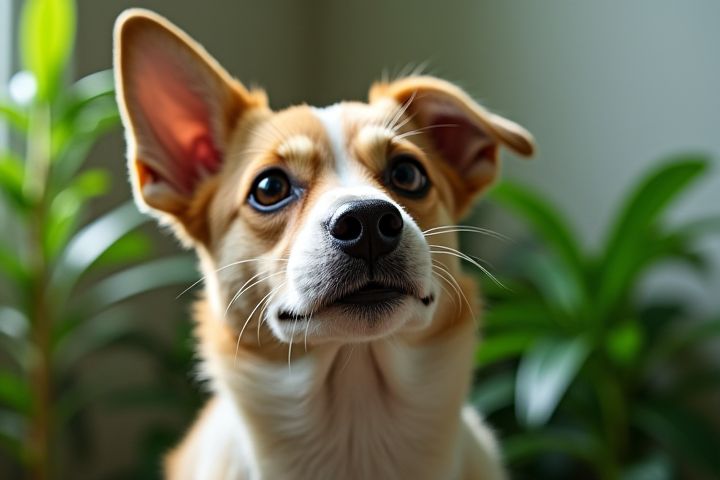
Many common houseplants can pose serious health risks to pets. For instance, plants like lilies, philodendrons, and azaleas are toxic to cats and dogs, often leading to symptoms such as vomiting, diarrhea, or even more severe complications. The ASPCA provides a comprehensive list of pet-safe plants, which includes varieties like spider plants, Boston ferns, and African violets. It's crucial to research the specific plants you keep in your home to safeguard your furry friends. If you suspect your pet has ingested a toxic plant, consult your veterinarian immediately for guidance and treatment options.
Are Houseplants Harmful To Pets
Toxicity varies by plant.
Toxicity varies significantly among houseplants, with some being safe for pets while others can cause serious health issues. Common toxic plants include lilies, azaleas, and pothos, which can result in symptoms such as vomiting, diarrhea, or even more severe reactions like kidney failure in cats and dogs. Conversely, pet-friendly options like spider plants and Boston ferns pose minimal risk and can enhance your indoor environment. Always verify a specific plant's toxicity before introducing it into a home with pets to ensure their safety and well-being.
Common harmful plants: lilies, philodendrons, sago palms.
Common houseplants such as lilies, philodendrons, and sago palms can pose significant health risks to pets. For instance, lilies are highly toxic to cats and can cause severe kidney damage, with even small ingestions potentially leading to fatal outcomes. Philodendrons contain calcium oxalate crystals that may lead to oral irritation, vomiting, and difficulty swallowing in dogs and cats. Sago palms are particularly dangerous; all parts of the plant are poisonous, and ingestion can result in liver failure, with symptoms like vomiting, diarrhea, and seizures appearing within just a few hours.
Symptoms include vomiting, lethargy, drooling.
Certain houseplants can be toxic to pets, leading to various health issues. Symptoms of poisoning may include vomiting, lethargy, and excessive drooling, which indicate your pet is experiencing distress. Common toxic plants include philodendrons, pothos, and lilies, with each exhibiting distinct harmful effects on animals. Always check the safety of houseplants before introducing them into your home to ensure the well-being of your pets.
ASPCA provides a toxic plant database.
Houseplants can pose varying levels of toxicity to pets, according to the ASPCA's extensive toxic plant database. For instance, certain common houseplants, such as philodendrons and pothos, contain compounds that can provoke gastrointestinal distress in cats and dogs. The ASPCA reports that ingestion of toxic plants can lead to symptoms like vomiting, diarrhea, or even more severe health issues depending on the type and quantity consumed. To ensure your pet's safety, it's essential to research any houseplants you introduce into your home and opt for pet-friendly varieties when possible.
Pet-safe plant options: spider plants, Boston ferns.
Houseplants can pose risks to pets, but several options are safe and non-toxic. Spider plants (Chlorophytum comosum) are pet-friendly and can thrive in various light conditions, offering air-purifying benefits. Boston ferns (Nephrolepis exaltata) also make an excellent choice; they provide a lush appearance and are safe for your furry companions. Incorporating these plants into your home can enhance aesthetics while ensuring the safety of your pets.
Keep plants out of reach of pets.
Certain houseplants can be toxic to pets, posing risks such as vomiting, diarrhea, or even more severe health issues. To keep your furry friends safe, ensure that plants like lilies, philodendrons, and pothos are placed out of their reach, preferably on high shelves or in rooms that pets cannot access. Regularly inspect your living space to identify any potentially harmful plants and take preventive measures by securing them. By being vigilant about plant placement and choosing pet-safe varieties, you can enjoy the benefits of indoor greenery without compromising your pets' health.
Pets may chew leaves out of curiosity.
Many houseplants can pose risks to pets, as curious animals may chew on leaves out of exploration. Certain plants, such as pothos, philodendron, and lilies, contain toxic compounds that can lead to adverse reactions in cats and dogs. Symptoms of ingestion may include vomiting, diarrhea, or even more severe health issues, depending on the plant. To ensure your pet's safety, it's important to research each plant before introducing it into your home, opting for pet-friendly varieties when possible.
Symptoms require immediate veterinary attention.
Certain houseplants, such as philodendrons and lilies, are known to be toxic to pets, leading to symptoms like vomiting, diarrhea, or excessive drooling. If your pet exhibits signs of distress after chewing on a plant, immediate veterinary attention is crucial. Other serious symptoms include difficulty breathing, lethargy, or seizures, which indicate a more severe reaction. Always research the toxicity of houseplants before introducing them into your home to ensure your pet's safety.
Rubber plants and aloe can cause irritation.
Rubber plants (Ficus elastica) contain latex, which can cause gastrointestinal upset and skin irritation in pets if ingested. Aloe vera, although beneficial for humans, can lead to vomiting, diarrhea, and lethargy in cats and dogs when consumed. Both plants should be kept out of reach of curious pets to avoid accidental ingestion. Educating yourself about the toxicity levels of houseplants can help ensure a safe environment for your furry companions.
Ingesting large amounts can be fatal.
Certain houseplants can pose serious health risks to pets, especially when ingested in large quantities. Plants such as oleander, azalea, and philodendron contain toxic compounds that can lead to severe symptoms and even fatalities in animals. Symptoms of plant poisoning may include vomiting, diarrhea, and lethargy, which are critical indicators that your pet has ingested something harmful. It's vital to be aware of the plants in your home and take precautions to safeguard your pets' well-being.
